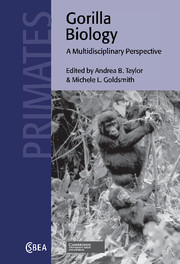Book contents
Introduction: Gorilla biology: Multiple perspectives on variation within a genus
Published online by Cambridge University Press: 11 August 2009
Summary
It is perhaps widely appreciated in the realm of primatology that until fairly recently, our perspective on gorillas has been an unbalanced one. Our earliest and most comprehensive accounts of gorillas in the wild can be traced almost entirely to studies of the East African gorillas of the Virunga mountains, Gorilla gorilla beringei or, as it is now being called by some, Gorilla beringei beringei, even though explorers' initial contacts were with the gorillas of West Africa. This is not unlike our early view of the chimpanzee, which for the better half of the twentieth century was based primarily on the chimpanzees of Gombe and the work of Jane Goodall, or our early view of the orangutan, which for years was informed by work conducted at only a few sites along the Bornean coast.
Pioneering work by well known field primatologists, such as George Schaller and Dian Fossey, provided the first systematic accounts of gorillas, cementing in our minds the image of these animals as plant-eating, quadrupedal, terrestrial knuckle-walkers. As a testimonial to the one-sided nature of these early gorilla field studies, the first important attempt to document the behavior of the western lowland gorilla is briefly noted by Schaller in the Preface to the Phoenix Edition of his landmark study The Mountain Gorilla, as “an interesting report on the little-known West African gorilla”.
- Type
- Chapter
- Information
- Gorilla BiologyA Multidisciplinary Perspective, pp. 1 - 8Publisher: Cambridge University PressPrint publication year: 2002

